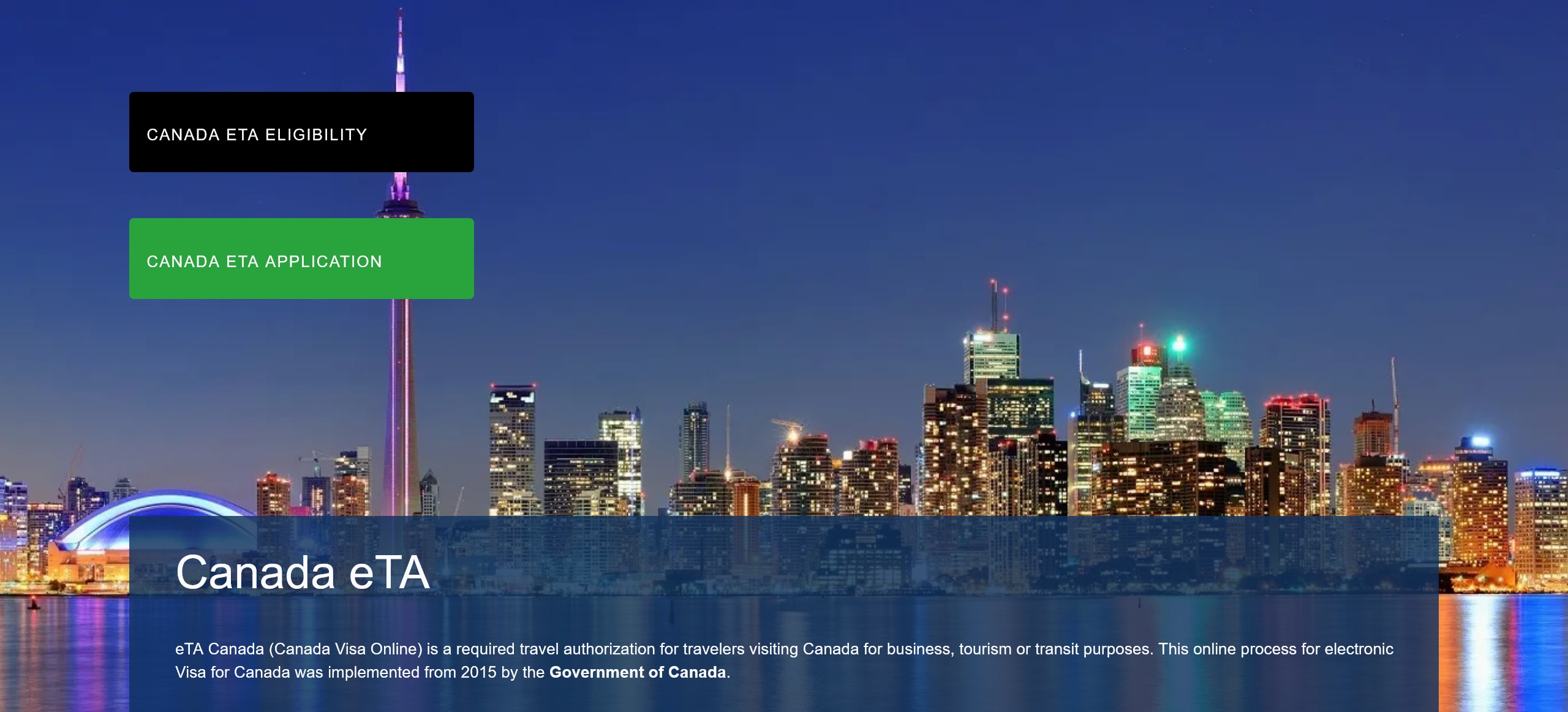How To Apply For Canada Temporary Resident Visa
ONLINE CANADA VISA APPLICATION
The visa issued by the Canadian embassy or consulate in your country of residence serves as confirmation that you meet Canada’s entry criteria. Some countries permit their citizens to apply for a Canadian visa online, while individuals from other countries must submit their application in person. Beginning in August 2015, individuals who plan to remain in Canada for more than six months are required to obtain an Electronic Travel Authorization (eTA). The majority of residents can visit Canada for tourism without needing a visa as long as they stay less than 180 days. The Canadian Tourist Visa, also referred to as the Canadian Visitor Visa or the Temporary Resident Visa (TRV), permits individuals to enter Canada for the sole purpose of tourism. They also have the option to obtain an eTA for Canada through online application. Usually, your Canadian visitor visa will be affixed to your passport (or another suitable travel document). This paper certifies that you meet the basic requirements to enter Canada legally. Furthermore, people of selected countries may apply for an Electronic Travel Authorization (eTA) to visit Canada. eTA is a new entry requirement for visa-exempt foreign nationals wishing to travel to Canada by air. Single-entry and multiple-entry visas are the two types of Canada visas available in Canada. Canada Visa Online is a visa waiver document that allows qualified foreign citizens of various countries (visa-free) to visit Canada without first obtaining a visa from a Canadian Embassy.
Types of Canada Visa
-
Temporary resident visa
-
Study permit
-
Work permit
-
Permanent resident travel document
What Are the Documents Necessary for a Canada Visa?
The following documents are necessary:
-
Your valid ID cards.
-
A Valid passport with minimum two blank pages
-
A Proper application for a Canada visa.
-
A receipt for Canada visa payments.
-
Proof of clean criminal record.
-
A medical examination certifying excellent health.
-
Photographs meeting the criteria for submitting photographs for a Canada visa.
-
Proof of financial standing
-
Proof that you will return home after your Canadian visa expires.
-
Documents proving your identity and marital status.
-
A letter explaining why you are visiting Canada.
The majority of international tourists flying into Canada and passing through to their ultimate destination are required to acquire a transit visa for entry and exit from the country. A transit visa, also known as a Temporary Resident Visa (TRV), must be obtained by individuals traveling from a non-visa-exempt country through Canada to another destination and planning to stay for under 48 hours. A transit visa doesn’t cost anything, but the application procedure is the same as for a TRV. The Canadian transit visa permits the person to stay in a Canadian airport for a maximum of 48 hours before proceeding to a different location. The visa may be issued as either a single-entry or double entry, based on the traveler’s itinerary. Travelers from visa-exempt countries are not required to obtain a transit visa to pass through Canada. They must, however, have a valid eTA if coming by air for transit purposes (with the exception of US nationals). If you are from a visa-required country and your international flight stops in Canada on its way to another country, or you will be connecting between two international flights in Canada, or you will transit through Canada in 48 hours or less and do not have a valid visitor visa, you will need a transit visa.
CANADA TEMPORARY RESIDENT VISA
If you are usually not allowed in, you might still be able to get a short-term permit to stay in Canada if you have a good reason. A Temporary Resident Visa (TRV) is a formal paper provided by a Canadian visa office and inserted into your passport showing that you have fulfilled the conditions for temporary stay in Canada (as a visitor, student, or employee). A immigration or border services official will assess if your intention to enter or stay in Canada is more important than the health and safety of Canadian society. Despite the seemingly minor nature of your inadmissibility, you still need to give proof to justify your visit. Having one of these visas means your time in Canada will be brief. As a result, you will be unable to apply for Canadian citizenship, obtain Canadian government paperwork, or receive Canadian benefits like medical coverage. You are only permitted to stay in Canada for the purpose for which you applied, and you are not permitted to work or study in Canada on a long-term basis. If you locate a study program with a period of 6 months or shorter, you may attend it, but only if you specify it in your application. Working is not permitted else. You must also demonstrate that you want to leave Canada and return to your home country. Applicants must follow a set of processes when applying for a Temporary Resident Visa. Because most application processes are being computerized, it is advised that you apply online if at all possible. Even if you apply online, if the Consulate demands interview or biometrics, you must appear in person. If you apply in person, you will need to return to the Consulate several times to complete the process.
HOW TO FILL NAME IN CANADA VISA APPLICATION
When filling out a Canadian visa application form, you will usually come across a section where you must provide your name. Here’s a step-by-step tutorial on correctly entering your name:
-
Read the instructions: Before you begin filling out the application form, carefully read the instructions provided. The instructions will guide you on how to complete each section accurately.
-
Determine the name format: Take into account the name format needed by the application form. In most circumstances, you’ll be asked for your entire name, which includes your first name, middle name (if applicable), and last name. Because the sequence of these names may differ based on your cultural background, please adhere to the format stated on the form.
-
Capitalization: Use proper capitalization rules when entering your name. Typically, the first letter of each name (first, middle, and last) should be capitalized, while the remaining letters should be lowercase.
-
Spacing: Pay attention to spacing between the names. Ensure that there is an appropriate space between your first name, middle name, and last name. Follow the format provided on the form.
-
Special characters and accents: If your name contains special characters, accents, or diacritical markings, ensure that they are included correctly. This is necessary to guarantee that your name appears accurately on all official papers.
-
Order of names: If your culture follows a specific order for names, ensure that you provide them in the appropriate order as per the instructions on the form. For example, some cultures place the family name first, followed by the given name.
-
Review for accuracy: Once you’ve entered your name, double-check it to make sure there are no spelling problems or missing information. Check that the names are in the correct sequence and that the format is followed.
-
Follow additional instructions: Some application forms may require you to provide additional information about your name, such as aliases or maiden names. If such instructions are provided, make sure to follow them accordingly.
The Super Visa program of the Canadian government allows parents and grandparents of Canadian citizens or permanent residents to visit and stay in Canada for an extended period of time. Here are some details on the Canada Super Visa for parents:
-
Purpose of the Super Visa: The Super Visa is intended to allow parents and grandparents to stay longer in Canada to visit their children or grandchildren. They can stay in Canada for up to two years without having to renew their status.
-
Multiple entries: The Super Visa, unlike an ordinary visiting visa, permits for numerous entries. This means that parents or grandparents can travel between Canada and their native country during the visa’s validity period.
-
Eligibility requirements: To be eligible for a Super Visa, the applicant must meet certain criteria, including a. The child or grandchild in Canada must be a Canadian citizen or permanent resident. b. The applicant must provide a written commitment of financial support from their child or grandchild in Canada, who must meet a minimum income threshold. c. The applicant must have valid Canadian medical insurance coverage for at least one year. d. The applicant must undergo a medical examination to demonstrate good health. e. The applicant must provide evidence of a genuine intention to leave Canada at the end of their authorized stay.
-
Application process: To apply for a Super Visa, the applicant needs to: a. Complete the application form (IMM 5257) and the Family Information Form (IMM 5645). b. Pay the required application fee. c. Provide supporting documents, such as a letter of invitation from the child or grandchild in Canada, proof of relationship, proof of financial support, and proof of medical insurance coverage. d. Undergo a medical examination by a designated panel physician. e. Submit the application to the appropriate Visa Application Centre (VAC) or Canadian embassy/consulate in their country of residence.
-
Processing time: Super Visa applications are typically processed within a few months, but processing times can vary depending on the volume of applications and other factors.
-
It is vital to note that the Super Visa and the Parent and Grandparent Program (PGP) for permanent residency are not the same thing. Although the Super Visa is only available for a limited time, the PGP allows parents and grandparents to apply for permanent residency in Canada. The PGP has a limited number of slots available each year and requires a particular application process.


